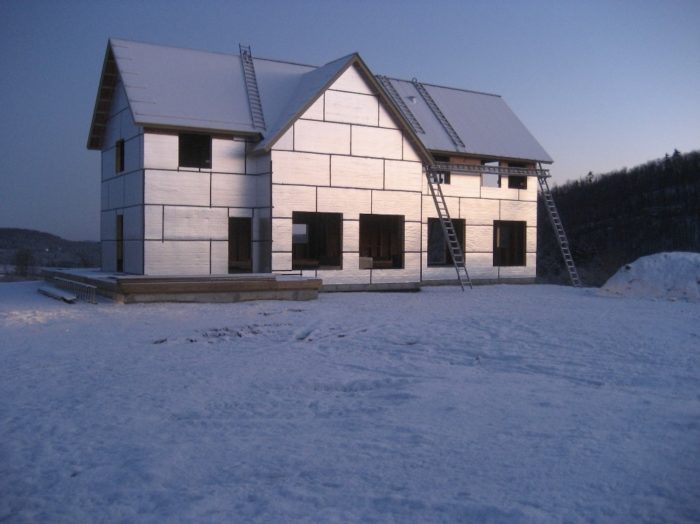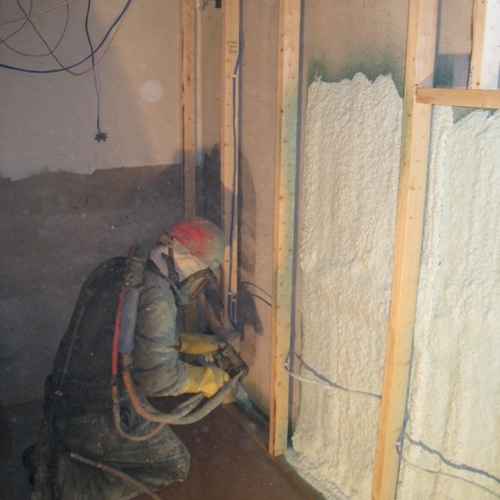Image Credit: David Pill
Image Credit: David Pill Solstice HFO blowing agents and refrigerant
Image Credit: Environmental Building News
Honeywell has introduced two new blowing agents that could dramatically reduce the global warming potential (GWP) of a variety of foam insulation types. Marketed under the brand name Solstice, they are designed to be “drop-in” substitutes for blowing agents currently used to manufacture insulation for both buildings and appliances, including extruded polystyrene and closed-cell polyurethane foams.
Both chemicals have zero ozone-depletion potential and a GWP of 7, meaning that when they are released into the atmosphere their potency is seven times that of carbon dioxide. While that may sound high, the chemicals they replace can have a GWP of hundreds or thousands. Since insulation reduces fossil fuel use, a GWP of 7 results in a very short global-warming payback time.
Weekly Newsletter
Get building science and energy efficiency advice, plus special offers, in your inbox.
XPS and SPF currently require potent greenhouse gases
As we have covered extensively on BuildingGreen.com and in the new insulation report from BuildingGreen, factory-produced polyisocyanurate insulation is produced today with hydrocarbon blowing agents with very low GWP. But extruded polystyrene (XPS) and most closed-cell spray polyurethane foam (SPF) today is made with hydrofluorocarbon blowing agents that are potent greenhouse gases — in fact, the HFC- 245fa used in most closed-cell SPF today has a higher GWP than the HCFC it replaced.
The gaseous Solstice blowing agent (HFO-1234ze) has been in use in Europe for XPS for a few years, but the liquid blowing agent for polystyrene and polyurethanes (HFO-1233zd) is new, and both are now being introduced worldwide. “We expect this to be a global solution replacing all types of blowing agents,” says Sanjeev Rastogi, structural enclosures director at Honeywell Fluorine Products. “If the molecule is adopted widely, we expect savings of about 60 million metric tons per year of CO2 equivalent,” he said.
Fourth generation of chemicals improves thermal performance
The new blowing agents — along with a refrigerant also being marketed under the name Solstice (HFO-1234yf) — are hydrofluoroolefins, or HFOs. This class of chemical is a “fourth-generation” family of compounds, developed to replace a long line of similar substances that had high ozone-depletion potential or GWP.
The first-generation chemicals, CFCs, had GWP as high as 10,900; use of these chemicals has long since been phased out through the Montreal Protocol, which also called for the phase-out of transitional second-generation blowing agents, hydrochlorofluorocarbons (HCFCs). HCFCs were duly succeeded by the third generation, hydrofluorocarbons (HFCs), which are now also being phased out — this time due to high GWP.
Honeywell has reported thermal performance improvements of 2%–5% (both initial and aged) of rigid and spray polyurethane foam manufactured with HFO-1233zd when compared with polyurethanes manufactured with HFC-245fa. According to Rastogi, thermal performance exceeds that of cyclopentane by 6% to 10% as well. “The blowing agent has a significant impact on thermal insulation value,” he says, “and we are still in the process of optimizing the formulations. We look at these numbers as the lower bound.”
Fluorinated chemicals raise environmental concerns
While low GWP is a huge and welcome breakthrough — and better thermal performance is a nice bonus — any use of fluorinated chemicals raises safety questions. Many halogenated compounds (those containing elements such as fluorine, bromine, and chlorine) break down into persistent chemicals, many of which are both bioaccumulative and toxic (PBTs). HFOs are relatively new, and their long-term environmental effects are unknown. However, like HFCs, they produce trifluoroacetic acid (TFA), which has “no known environmental degradation mechanisms,” according to Scott Mabury, Ph.D., professor of environmental chemistry at the University of Toronto. Mabury says that despite its persistence, “TFA has not been shown to be biologically very problematic, even at very high concentrations,” adding that “global warming is a bigger item than TFA’s going to be.”
According to Tom Lent, policy director at the Healthy Building Network, however, not everyone is so confident, and “with something as persistent as this, we can’t afford to be wrong.” From what we know right now, however, the new HFOs do not appear to be more problematic than the HFCs they replace.
Industry likely to promote environmental benefits
“We’re looking forward to it as an industry,” says Rick Duncan, Ph.D., P.E., technical director at the Spray Polyurethane Foam Alliance. “While 245fa-based spray foams have excellent R-values, the molecule’s high GWP has been viewed by some as a limiting factor in selection of closed-cell SPF products.”
Although he characterized the transition to a new blowing agent as a major project that takes about a year, Duncan believes that when manufacturers see results of life-cycle assessments recently completed by his organization, “several will take the opportunity to look at newer blowing agents and promote these more environmentally friendly products.” He expects the same data “will catch the interest of green builders, designers, and some consumers.” Duncan estimated that we could start seeing fourth-generation blowing agents in closed-cell spray polyurethane foam products as early as mid-2013, adding that DuPont and Arkema had also recently announced the impending launch of their own low-GWP blowing agents.
This week’s post was written in collaboration with Paula Melton of Environmental Building News.
For more guidance on environmental impacts of insulation materials, and guidance on the best material for the given application, please see The BuildingGreen Guide to Insulation Products and Practices.
>Tristan Roberts is Editorial Director at BuildingGreen, Inc., in Brattleboro, Vermont, which publishes information on green building solutions.

















9 Comments
Great info
Another excellent piece, Tristan!
Trading toxins
Agreed, an excellent piece. Clearly the problem with foams is always going to be that we're always looking backwards - we solve one problem, then a few years later look back at the problems we didn't know about at the time. These products are wonderful and solve various problems, but I think I will always look at foam as the last-resort insulation solution.
GWP of Insulation
Over here (the UK) we have got used to using blowing agents with a GWP of <3. (Encouraged by BREEAM materials points etc.) So whilst this may be a good step forwards there is still plenty more that can be done. There do not appear to be any issues in terms of affordability (so the these safer gases don't have an adverse impact upon budget.)
Mark
GWP ?
Thanks for this great article. It is nice to see an evolution taking place here in the US. I am remembering Alex's article from a couple or few years ago on the GWP of insulation. Then David Whites GWP of insulation calculator, he released last spring. Great Work! Thanks for leading the charge!
Is there any data as to how these new blowing agents affect off gassing over time? Are the Methyl- Butyl isocyanates eliminated?
What about the other issues with SPF's ?
I have to agree with both Dan and Mark . It is still foam. I works great for a plethora of situations, especially in Retro's where it is difficult to establish an effective vapor barrier in existing construction. I feel like it will always have to be a last resort though.
detailed air sealing and cellulose is cooler, IMHO . GWP of 85% recycled newsprint? Not zero, but its pretty close.
Global Warming Potential
I am a Mechanical Engineer that worked for GE at one time building power plants. I started my building career specializing in passive solar design and construction 16 years ago. I was building houses beyond energy star efficiency before anyone had heard of it. I was featured in the local paper as “A New Light in Solar Construction” in 1999. I was one of the first in the area to start using sealed crawlspaces. I built the first sealed attic house in Orange County, NC. I have been using open cell foam insulation for ten years. I do these things to help my buyers reduce their cost of ownership, and have a healthier, safer, quieter house; not because I have been fooled by junk science. Saying something has a “Global Warming Potential seven times that of CO2” demonstrates only the power of relentless propaganda.
It is my sincere hope that within the next year the horribly destructive scam of “Man Made Global Warming,” and the useless forced reactions by business to this fraud, can be put to rest forever. There is no so-called “greenhouse effect” happening, or even possible in our atmosphere. The only correlation between CO2 and temperature is that a warmer earth eventually results in more CO2 coming out of solution in the oceans. The most accurate (and uncorrupted) measurements of an average global temperature show a cooling of 0.3C between 1998 and 2008, as CO2 levels continued to go up. Theory disproved, again! When a theory is disproved over and over; when its advocates are caught lying and fabricating data; when skeptics are targeted for personal destruction, (when comments like this are quickly erased from blogs?) and still it persists, then it can no longer be called a theory. It must be recognized for what it is - a political movement.
Finally, it has recently been shown beyond all doubt at the most respected center of science on earth (CERN) that, guess what! It’s the SUN and clouds that control the temperature of our planet, not CO2. And there is absolutely nothing we can do about it. All this is explained in the just published little book called “The Birth and Death of Man Made Global Warming” available as an ebook at Amazon for 1.99. The people behind the decades of lies and fabrications about “climate change” are irrational anti-capitalists and population control radicals. I refuse to be one of their victims; as should every other intelligent citizen.
Response to Bruce Weber
Bruce,
Anti-scientific rants like yours, which are distressingly common in the U.S., are almost unknown in Europe. Educated people from other countries just shake their heads when they learn of the political power of global-warming deniers in the U.S.
Suffice it to say that 98% of climate scientists disagree with your conclusions.
So, Bruce...
The heat in a greenhouse doesn't come from the glass, it comes from the SUN! Okay, no argument there.
Four laws of Ecology
Kudos to Honeywell for getting this out and getting some press. (Dow... BASF... asleep? ...zzzzz).
Kudos to Tristan for discussing more than a single attribute and reminding everyone of the potential un-intended consequences when we substitute one ingredient for another. (the energy folks love their blinders so much.)
For those of us that may have forgotten... The Four Laws of Ecolgy:
1. Everything is connected
2. Everything goes somewhere
3. There is no free lunch
4. Nature bats last.
(Bruce, everything has an impact. Conspiracy theory? really. C'mon man. Life is too short. Yes, the researchers should have called it Climidia instead of Global Warming, but physics is still physics.)
Retro-fit applications
Hopefully this is the right forum to ask a question of some of the experts here. I'm a small home performance retro-fit contractor. First let me say that in terms of new homes I think with detailed air sealing (something done easily during the construction process) there are plenty of options for insulation other than SPF, and most are more cost effective. That said in retro-fits SPF is quite possibly the best thing to ever come along. It's ability to insulate and air seal quickly and effectively in confined spaces is undeniable. In fact it is probably what makes high quality retro-fits possible and by that I mean affordable. To do the same work by any other means would be extremely labor intensive and still not yield the same level of results. So, two questions. First, single component can foam looks to me not to use any of the blowing agents in question, am I right in this? Second, for rims, crawls, kneewalls, and pointed air sealing in retrofits are these foams worth it? Though I'm not looking to be a spray foam contractor (generally sub out large stuff) I'm looking at a refill system for air sealing purposes. There is virtually no landfill waste involved, which I like, but it's blown with 134a (which looks to be bad stuff). It's awful to think that the SPF I've used is doing more harm than good. It's also frustrating that with all this debate the most crucial question, how much does this stuff off gas and over what period of time, seems to be unanswered. Looking for opinions.
Log in or create an account to post a comment.
Sign up Log in